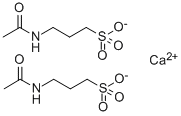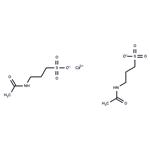Description
Acamprosate is an acetylated derivative of the GABA analog homotaurine (tramiprosate; ). Despite its structural similarity to GABA, acamprosate does not act at GABA
A receptors but does decrease paired-pulse inhibition of GABA
A inhibitory post-synaptic currents (IPSCs) at short inter-stimulus intervals when used at a concentration of 300 μM, indicating that it may inhibit GABA
B autoreceptor-mediated inhibition of GABA release. It is an NMDA receptor modulator with antagonist or agonist effects depending on brain region, receptor subunit composition, and other factors. Acamprosate (0.26 and 0.52 mmol/kg per day, i.p.) reduces voluntary intake of ethanol in rats, an effect that can be blocked by the GABA antagonist bicuculline . Formulations containing acamprosate have been used for the maintenance of alcohol abstinence.
Chemical Properties
Acamprosate calcium is White Crystalline Solid
Uses
Of interest for the treatment of alcoholism. Store at -20°C
Uses
glucocortcoid, antiinflammatory
Uses
Acamprosate calcium is a synthetic amino acid and a neurotransmitter analogue that is used as an alcohol deterrent in management of alcohol dependence and abuse. Acamprosate calcium was approved for use in the therapy of alcohol dependence and abuse in the United States in 2004.
Uses
Of interest for the treatment of alcoholism and other neurochemical disorders.
Definition
ChEBI: Acamprosate calcium is an organic calcium salt. It contains an acamprosate(1-).
Manufacturing Process
In a 4 liter flask provided with stirring means, a bromine funnel and a
thermometer, 17.5% sodium hydroxide solution and aminopropanesulfonic
acid (homotaurine) are added.
After complete dissolution, at a temperature of between 25°-40°C, acetic
anhydride are added so as not to exceed a temperature of between 30°-40°C.
The mixture is then maintained at this temperature by heating for at least 1
h.
The solution is then concentrated in vacuum, the residue is redissolved in 2.5
L of distilled water and the mixture is concentrated again. The residue is then
dissolved in 1.6 L of distilled water, filtered, then concentrated almost
completely. Drying is terminated in an oven in vacuum. A colorless crystalline
powder of 3-acetylaminopropanesulfonate of sodium (sodium Nacetylhomotaurinate)
is obtained.
The 3-acetylaminopropanesulfonic acid may be produced by treatment of 3-
acetylaminopropanesulfonate of sodium with hydrochloric acid.
In practice it is usually used as calcium salt.
brand name
Campral (Forest).
Therapeutic Function
Psychotropic
Biological Activity
GABA receptor agonist and modulator of glutamatergic systems. Reduces alcohol consumption in animal models of alcohol addiction.
Biochem/physiol Actions
Acamprosate calcium is a GABA γ-aminobutyric acid agonist.
Clinical Use
Maintenance of abstinence in alcohol dependence
Metabolism
Acamprosate is excreted in the urine and is not
metabolised significantly.
storage
Room temperature (desiccate)
References
1. wilde m i, wagstaff a j. acamprosate. drugs, 1997, 53(6): 1038-1053.



